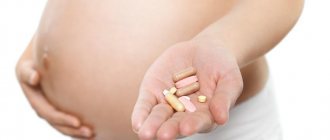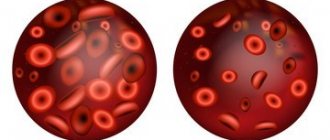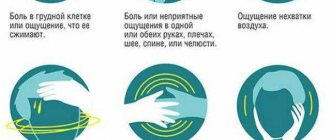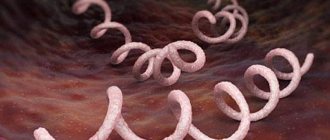08/21/2014 | Anemia (anemia) is a condition characterized by a lack of oxygen in the body, which occurs as a result of a decrease in hemoglobin in the blood plasma and a decrease in the number of red blood cells (erythrocytes). This causes changes in the vitamin balance and a decrease in the amount of enzymes and microelements in the body.
Anemia is a common complication during pregnancy. The leading sign of the pathological condition is a decrease in hemoglobin by less than 110 g/l. In 90% of pregnant women, the disease occurs due to insufficient iron content in the body.
The very first symptoms and signs of pregnancy in the early stages.
First trimester of pregnancy
Causes of anemia during pregnancy
Pregnancy is a condition in which a large burden is placed on the female body, which is associated with decreased immunity and hormonal imbalance. The causes of the disease may be factors due to which the woman’s body experienced iron deficiency during pregnancy, as well as before its onset. These include:
- Chronic alcoholism;
- Frequent nosebleeds and other bleeding;
- Gynecological diseases (endometriosis, uterine fibroids);
- Heavy and/or prolonged menstruation;
- Polyhydramnios;
- Hormonal disorders and use of hormonal contraceptives;
- Long-term diseases occurring in a chronic form;
- Diseases that disrupt the normal absorption of iron and its transportation to tissues and organs (pathologies of the stomach, liver, intestines);
- Not a complete diet that does not include the consumption of fortified foods;
- The age of the woman (less than 18 years and more than 30).
The body's need for iron also increases during multiple pregnancy. In this case, he needs this element 2 times more than when carrying 1 fertilized egg. The risk group for anemia includes women who have had a second pregnancy earlier than 4-5 years after the previous birth.
This is due to the fact that during the entire period of bearing a baby and during lactation, the female body loses from 800 to 900 mg of iron, which can only be restored after a long time. This disease is also inevitable in women who have given birth to four or more children.
Causes of anemia in pregnant women
However, pregnant women often develop true anemia. In Moscow, St. Petersburg and many other cities of Russia, it is detected in 40% of expectant mothers. In different countries, the incidence of the disease ranges from 21 to 80%.
Most often (in 90% of cases), iron deficiency anemia is diagnosed - a condition in which the body lacks one of the main components of hemoglobin - iron. Many people have a hidden deficiency even outside of pregnancy. It is available, for example, to 85% of women in the so-called third world (backward countries of Africa, Asia and South America). In central Russia, including Moscow, iron deficiency is detected during examination in 15% of women, in the former Central Asian republics - in 40% of city dwellers and in 80% of village residents.
One of the reasons for anemia in pregnant women is that the digestive organs cannot, no matter how many iron-containing foods a person eats, absorb more than 2 mg of iron per day. With sweat, urine, falling hair, and exfoliating skin epithelium, 1 mg of iron is excreted from the body per day. Women of childbearing age lose 1-50 mg (some up to 60) during menstruation, and 20% lose more than 60 mg of iron. During these days, only 20 mg of iron comes from food.
A deficiency of 30 mg is restored from the body’s reserves (depot) in an average month - in the interval from one menstrual cycle to another. The total amount of iron in the depot is 4 g. During pregnancy, childbirth, and breastfeeding, 0.6-0.7 g of iron is consumed. After all, it is required not only by the mother, but also by the child’s body.
Various factors predispose to the development of anemia in pregnant women. This is a decrease, for example, in the intake of iron from food. Often the reasons lie in impaired absorption of iron in the intestines, in bleeding from the gastrointestinal tract (with hemorrhoids, gastric ulcers), during pregnancy, for example, with placenta previa). Anemia is provoked by vomiting caused by toxicosis, frequent pregnancies, multiple births (twins, triplets), prolonged breastfeeding, and some chronic diseases (hepatitis, pyelonephritis and others). Anemia is more often detected in winter and spring, when there are few vitamins in food.
Hematopoiesis is greatly influenced by sex hormones. Male (androgens) enhance iron absorption, but female (estrogens) do not. Therefore, at puberty, during the period of formation of sexual function, girls may develop anemia, which later transforms into anemia of pregnant women. And most often, this disease, diagnosed in the early stages of pregnancy, existed even before its occurrence. Anemia, associated directly with pregnancy, develops, as a rule, in the second half.
What is the danger of anemia during pregnancy?
Every third pregnant woman, due to anemia, suffers from gestosis - a complication in which the normal activity of all organs and tissues in the body is disrupted. The brain and heart begin to function poorly, the liver does not produce a sufficient amount of protein, which is necessary for the construction of cells, toxins are no longer eliminated in full, both in the woman and the child, there is a small rush of blood, resulting in oxygen deficiency.
The disease can also cause complications, which include:
- Premature birth or miscarriage in 21.5% of cases;
- Premature placental abruption, as well as rupture of amniotic fluid;
- Bleeding during childbirth;
- Intrauterine growth retardation in 25%;
- Toxicosis;
- Fetal hypoxia;
- Postpartum complications of an infectious nature;
- Stillbirth (with severe anemia);
- Weakening of labor;
- Insufficient production of milk in the breast.
Hemoglobin is the main supplier of oxygen and nutrients necessary for the baby. If there is insufficient iron content in a pregnant woman's body, hemoglobin deficiency occurs, as a result of which the embryo begins to lack oxygen. Essential nutrients, without which a child cannot grow and develop normally, are supplied in insufficient quantities.
Every 3rd child born to a mother who suffered anemia during pregnancy often suffers from respiratory diseases, 29% have allergies, and 23% have anemia.
Prevention
According to the prescriptions of the World Health Organization, all pregnant women in the second half of pregnancy and during lactation are prescribed iron supplements in order to maintain the level of the substance in the blood and prevent anemia.
To prevent anemia in pregnant women, doctors recommend the same medications as for treating the disease. The main preventive measures for women susceptible to anemia in the second half of gestation consist of prescribing iron supplements in a small dosage of 1-2 tablets for six months, starting from 12-14 weeks of gestation. The course lasts 14-21 days, after which a break is taken for the same period. Then the medication is resumed. During the entire pregnancy, up to five such courses are carried out.
In addition to drug prevention of anemia, diet correction is carried out in favor of increasing meat and dairy products, vegetables and fruits.
Anemia during pregnancy is a common ailment that is highly treatable if the problem is detected early. During the gestation period, the female body spends reserve forces on creating a new life, which is why its own reserves of vitamins, minerals and other substances necessary for normal functioning are depleted. Preventive intake of iron-containing medications and a sufficient supply of ions of this element with food will protect the expectant mother from an unpleasant illness.
Author: Yulia Sivitskaya, doctor, especially for Mama66.ru
What are the degrees and classes of the disease?
The disease is divided into 3 degrees according to the severity of its development. Experts highlight:
- 1st degree (the easiest). Hemoglobin level is 110-91 g/l;
- 2nd degree (moderate). Diagnosed when the hemoglobin level is 90-71 g/l;
- 3rd degree (the most severe). Hemoglobin with it drops to 70 g/l. and below.
Features of each degree:
- At the beginning of the development of anemia, a woman does not experience any inconvenience. But with timely treatment, the risk of the disease progressing to a more severe degree can be prevented and thereby relieved of health problems for the woman and her baby;
- When the disease progresses to stage 2, the pregnant woman begins to feel discomfort, since the lack of iron affects not only her health, but also in terms of cosmetology;
- The last stage of anemia requires immediate treatment in a hospital setting, as it poses a serious threat to the health of the child and mother.
According to etiology, the disease is divided into classes, since it can occur due to various factors:
Anemia associated with poor nutrition:
- Folate deficiency;
- With a deficiency of element B12;
- Iron deficiency.
- Hemolytic anemia:
Hemolytic anemia resulting from:
- Hereditary factor;
- For crescentic disorders;
- For thalassemia;
- Enzyme changes.
Aplastic anemia:
- Posthemorrhagic acute anemia;
- Aplastic anemia;
- Erythroblastopenia (hereditary red cell aplasia).
Caused by chronic diseases:
- For neoplasms;
- Gynecological and other diseases;
Therefore, it is important to take timely tests, which are prescribed by the doctor leading the pregnancy, which makes it possible to identify a disease that is not the 1st degree of development and eliminate serious consequences.
general information
Anemia is not a completely independent disease. It often develops when the number of red blood cells decreases and red blood cell recovery/regeneration does not make up the difference.
A similar situation is often observed in the presence of blood loss. Women have a predisposition, since menstruation is a loss of blood, albeit physiological. If the monthly blood loss is very large, for example, heavy and prolonged periods, then anemia will increase.
Causes
The following factors contribute to the development of anemia:
- Poor, one-sided nutrition. Prevalence of dairy products in the diet.
- Low or insufficient presence of vitamin-rich foods in the diet.
- Diets for weight loss, snack eating.
- Frequent colds.
- Presence of helminthic infestations.
- Presence of chronic systemic diseases.
Anemia is diagnosed by a blood test. The initial criterion is the hemoglobin (Hb) level.
| Women over 15 years old (outside of pregnancy) | Women during pregnancy |
| 120-140 g/l 12.0-14.0 g/% | 110-105 g/l 11.0-10.5 g/% |
Effect on the body
What happens to the body when the level of hemoglobin decreases and what is the connection between this protein and red blood cells? Red blood cells, erythrocytes, are very elastic cells. They “take” oxygen from the lungs and deliver it to all tissues of the human body. Having given up oxygen, red blood cells “collect” carbon dioxide and carry it to the lungs.
Hemoglobin is found in red blood cells. This is an iron-containing protein that transports oxygen/carbon dioxide. Thanks to this protein, which is part of red blood cells, human blood is red.
If the body loses the required amount of red blood cells, and therefore hemoglobin, then cells and tissues begin to suffer from hypoxia (lack of oxygen). At this time, the first symptoms may appear. For example, flashing spots before the eyes, weakness, dizziness, loss of appetite. However, our body can adapt to a lack of oxygen. Compensatory functions are included.
Hypoxia triggers an interesting process. From oxygen starvation, the nervous system becomes excited. The heart, receiving the signal, begins to contract more often, thereby accelerating blood circulation. And since blood circulation flows faster, the supply of oxygen to tissues is more intense. This is the mechanism for compensating for the lack of red blood cells/hemoglobin. Therefore, with anemia there are often no symptoms, the body learns to cope.
Classification
The classification of anemia depends on various factors underlying the phenomenon. This may be folate deficiency or normochromic anemia, aplastic or posthemorrhagic anemia. Women are most often diagnosed with iron deficiency anemia.
There are three main degrees of anemia.
| Hemoglobin level | Severity |
| Less than normal, but above 90 g/l | Light |
| From 90 to 70 g/l | Average |
| From 70 or less g/l | Heavy |
Symptoms and signs of anemia
Anemia at an early stage of development does not have clearly defined symptoms. With this diagnosis, the woman does not feel any changes in her well-being. She can only find out about the disease through a blood test.
The child immediately feels the changes taking place in the mother’s body, as she experiences oxygen starvation, albeit insignificant.
With a large decrease in hemoglobin, which is characteristic of degree 2 anemia, the following symptoms may occur:
- Frequent fainting;
- Rapid pulse;
- Dizziness;
- Fast fatiguability;
- Weakness;
- Irritability;
- Pain in the heart area;
- Decreased memory and attention;
- Decreased appetite;
- Damage to the digestive organs.
Often the disease changes a woman’s appearance, which is manifested by the following symptoms:
- Palms peel and turn yellow;
- Cracks on the lips often occur;
- Nails break easily;
- Hair fall out;
- The skin becomes pale;
At stage 3, the symptoms are the same, but in a more severe form, which poses a serious danger to both mother and baby.
How is anemia detected during pregnancy?
The presence of the disease can only be determined by the results of a blood test. Thanks to this study, the doctor can confirm or deny the development of anemia. The first indicator of the analysis determines the amount of hemoglobin, and the other - hematocrit (reveals the percentage of red blood cells).
There may not be anemia at the beginning of pregnancy; it may appear during gestation, especially in the 2nd and 3rd trimester, when the fetus develops with high intensity and requires a large amount of nutrients for its normal development.
In the second half of pregnancy, hemoglobin and red blood cell levels decrease slightly, and this is considered normal. Danger appears when they fall sharply and forcefully. Therefore, during the 2nd and 3rd trimester, tests are taken once every 2 or 1 week.
Symptoms of anemia
How does the disease manifest itself? Some people do not feel it, and therefore may not present any complaints to the doctor. Others are concerned about the symptoms of anemia in pregnant women: weakness, shortness of breath, dizziness, fainting, and often trophic changes associated with a deficiency of iron-containing enzymes in the body. Then there is hair loss, brittle nails, cracks in the corners of the mouth, yellowness of the palms and the triangle under the nose, the desire to eat chalk, erasers, sniff liquids with strong odors, involuntary urination and bowel movements are possible. With severe anemia, heart failure may develop with rapid heartbeat, edema, and decreased blood pressure.
Types of anemia
- Blood tests for true anemia reveal less than 115 g/l of hemoglobin, a color index below 0.95, and a serum iron level below 10 mmol/l. And the fact that this is not hydremia is indicated by the altered erythrocyte cells found in the blood smear - poikilocytes and anisocytes.
- Anemia is considered to be mild when the amount of hemoglobin is in the range of 115-90 g/l; anemia with a hemoglobin level of 89-90 g/l is considered a moderate disease, and anemia is considered severe if the hemoglobin level is less than 80 g/l.
Anemia contributes to the development of various pregnancy complications. Toxicoses appear 1.5 times more often than in healthy women. In particular, late toxicosis of pregnant women, which is accompanied by edema, protein in the urine, and high blood pressure, is diagnosed in 40%, miscarriages, premature birth in 15 - 42% of pregnant women. And there are difficulties in childbirth. Children whose mothers suffered from anemia by the age of one year are also often found to have iron deficiency.
Some women can be expected to develop anemia during pregnancy. These are those who previously had it, have chronic hepatitis, pyelonephritis, as well as multiparous women and women whose hemoglobin did not exceed 120 g/l at the beginning of pregnancy. All of them require mandatory preventive treatment. It usually consists of prescribing an iron supplement, which is recommended to be taken for 4-6 months, starting from 14 weeks of pregnancy.
How to get rid of anemia during pregnancy
The disease must be treated under the strict supervision of a doctor. There are a lot of drugs that do not cause side effects on the fetus, but not all of them are harmless to women. The drugs differ from each other in the percentage content of both iron and additional components included in the drug. Each woman reacts differently to them. Eg:
- Ferroceron - can cause dyspepsia and urinary disorders, so it is best to avoid taking it if possible;
- Ferroplex and ferrocal - have a small number of side effects. They are well tolerated during pregnancy, so their use is possible in large doses (2 tablets / 3-4 rubles / day);
- Conferon - contains a large amount of iron. Its use is indicated in small doses (1 drop/3 times/day). The drug may cause depression;
- Gyno-tardiferon and Tardiferon are drugs containing folic acid. Taken for the treatment of anemia (1 tablet/day, 2 tablets); as a preventive measure, 1 tablet/day is sufficient.
The doctor prescribes medicines containing iron in tablets and capsules, since injection administration gives complications, without having any advantages. Administration intravenously and intramuscularly can cause the following reactions:
- Shock;
- Impaired blood clotting functions;
- Abscesses;
- Infiltrates.
Injections are prescribed only for diseases of the digestive organs (with exacerbation of peptic ulcers) or if the body is intolerant of the drug.
The treatment process for the disease is quite long. Hemoglobin levels begin to increase after 3 weeks from the start of therapy and are fully restored after 10 weeks. Treatment cannot be interrupted even if you feel better; the course must be completed in full. After birth, maintenance therapy is recommended for 6 months.
Treatment of anemia is carried out on an outpatient basis; a woman is hospitalized only in severe cases.
Treatment
Treatment of anemia during pregnancy is a long process. The primary increase in the number of reticulocytes occurs 9-12 days after starting to take medications in the correct dosage. However, an increase in iron levels does not mean that therapy can be stopped. A persistent increase in hemoglobin is recorded only 6-8 weeks after starting to take the drugs. This is why the consumption of the medicine continues for several months.
In addition to iron compounds, pregnant women with low hemoglobin levels are prescribed B vitamins, including folic acid and cyanocobalamin. A hematologist treats anemia in pregnant women, so it is he who prescribes a therapeutic dose, which depends on the individual characteristics of the body and the degree of deficiency of the substance in the blood.
What should nutrition be like for anemia?
Proper diet is an important factor in this disease. It is necessary that it includes products containing large amounts of iron. These products are:
- By-products – chicken, beef, pork liver and beef tongue;
- Meat – lambs, turkeys, rabbits, calves, chickens;
- Cereals – barley, millet, oatmeal, buckwheat, rice;
- Fish – mackerel, pink salmon and sturgeon caviar;
- Greens - lettuce, sorrel, spinach, dill, parsley;
- Fruits and berries - plums, persimmons, apricots, quinces, apples, blueberries, peaches, watermelon, gooseberries, strawberries, cherries;
- Vegetables – cabbage, beets, carrots, tomatoes;
- Pasta;
- Chicken eggs;
Doctors recommend consuming dark honey; it contains many essential microelements and vitamins.
Some foods interfere with the absorption of iron, so it is best to exclude them from the diet if possible, these are:
- Beef and lamb fats;
- Sausages of fatty varieties;
- Margarine;
- Fatty meats.
Due to their high fat content, the listed products do not bring any benefit, but only contribute to disruption of the iron absorption process. An approximate daily diet is described in the table:
| Stages of eating | Balanced meals containing iron |
| Breakfast | Vegetable salad, buckwheat porridge + stewed chicken liver and herbal decoction. |
| First snack | Hard-boiled chicken egg and 2 apples. |
| Dinner | Vegetable soup, chicken breast baked in the oven + tomato salad with added herbs, a piece of rye bread, any fruit. |
| Second snack | Low-fat or low-fat cottage cheese with the addition of a spoon of honey. Elderberry decoction. |
| Dinner | Tomato and spinach salad + baked fish, bread made from second-grade wheat flour, fruit salad. |
| Afternoon snack | A glass of fermented baked milk or kefir. |
Nutrition during illness should be as healthy as possible, containing the required amount of iron, protein, and other vital vitamins. If you encounter difficulties when preparing your daily diet, you should seek help from a nutritionist or your doctor.
Vitamins and their importance for anemia
The leading role of insufficient folic acid and iron in the development of the disease is undeniable. But the influence of other vitamins should not be underestimated. Each useful element has its own role:
- E - protects the placenta from the negative effects of various factors. Contained in rose hips, tomatoes, green salad, peas, parsley and spinach, as well as in olive, corn and sunflower oil;
- C is a natural antioxidant, helps the body absorb iron and improves its quality. A large amount of it is found in citrus fruits, bell peppers, cabbage, baked potatoes and black currants;
- Folic acid or B 9 – prevents the occurrence of anemia. Contained in yeast, nuts, honey, liver, leaves of green vegetables;
- B 6 – the drug is a stimulator of metabolic processes in the body, helps the digestibility of protein, the production of hemoglobin and red blood cells. Included in legumes, fish, meat and nuts;
- At 12 – insufficient content of this element in the body leads to anemia. You can make up for its deficiency with the help of a “medicinal cocktail”: 1 tsp. honey, the same amount of brewer's yeast + a glass of milk.
To prevent the development of anemia, it is important to take vitamin complexes for pregnant women, such as:
- Elevit - the complex includes 12 types of vitamins and 7 minerals; these numbers contain enough iron and folic acid and iron. The drug can be used both during pregnancy and when planning it. Daily dosage: 1 tablet, which should be taken after eating;
- ALPHABET Mom's health is a multivitamin complex consisting of tablets of different colors. Each of them contains different complexes of minerals and vitamins that combine well with each other. If a woman is allergic to one of the drugs included in the tablet, she can be excluded from taking it. You need to take 1 vitamin of each color per day;
- Materna is a vitamin-mineral complex consisting of B vitamins and element A. These vitamins should be taken when the body is critically short of these elements. Otherwise, allergic reactions are possible. The vitamin complex consists of capsules and tablets. You need to take 1 capsule and 1 tablet per day;
- Complivit Mama is a vitamin and mineral complex containing a small amount of iodine, vitamin D and A. During pregnancy in winter, the need for B vitamins increases significantly. With the help of this complex it is impossible to satisfy the body's need for element B. Therefore, it is preferable to take it in summer and autumn. You need to take 1 vitamin. per day;
- Vitrum prenatal is a complex of vitamins and minerals, which is indicated during pregnancy planning, gestation and after childbirth. It contains a sufficient amount of B vitamins and iron. However, it does not contain iodine at all, so when consuming it, it is necessary to take the drug “Iodomarin” in parallel. You need to take vitamins during breakfast, 1 tablet per day.
Before choosing one of the vitamin complexes for pregnant women, you should consult with your direct gynecologist who is monitoring your pregnancy.
- mommy!
Anemia in Pregnancy Anemia is a fairly common condition during pregnancy. In fact, in 2/3 of expectant mothers, a general blood test shows a decrease in hemoglobin and the number of red blood cells. The main reason for the development of anemia during pregnancy is a lack of iron in the mother's body, which leads to a decrease in hemoglobin synthesis. This anemia is called iron deficiency.
Hemoglobin is an important protein compound responsible for the transport of oxygen to organs and cell metabolism products to the body’s natural filters - the liver, kidneys and lungs.
Why does iron deficiency occur during pregnancy?
Iron is consumed at an increased rate during pregnancy. The main “item of consumption” is this element is necessary for enhanced hemoglobin synthesis. After all, oxygen and nutrients need to be delivered not only to the mother’s organs, but also to the baby. Therefore, the heart begins to beat faster, and breathing becomes more frequent, and the need for oxygen increases due to the increased load.
In addition, iron is required for the growing uterus - for the construction of muscle fibers, and for the construction of the placenta.
Another “main consumer” of mother’s iron reserves is the child. For a baby, this important microelement is necessary at all stages of embryogenesis - from the formation of tissues and organs to the creation of its own circulatory system and blood cells.
It turns out that you need a lot of iron, but a woman can get no more than 2 mg of this element with food - she cannot absorb more through the gastrointestinal tract, even if the diet is enriched with iron-containing products.
Because of this discrepancy between the consumption of iron and the replenishment of its reserves, a deficiency results.
When does iron deficiency anemia develop?
Iron deficiency is not anemia. There is a deficiency classification that helps diagnose anemia.
- 1. Prelatent iron deficiency. The content of this element in tissues decreases, but serum iron and hemoglobin remain normal. 2. Latent iron deficiency. Iron reserves in the depot are depleted, but hemoglobin is still within normal limits. 3. Iron deficiency anemia. There are practically no iron reserves, the hemoglobin concentration is below the physiological norm.
Normally, a woman’s hemoglobin content varies between 120-140 g/l . During pregnancy, the lower limit of normal drops to 110 g/l . This depends on the increase in the volume of mother’s blood due to the liquid component - plasma, and, accordingly, the relative concentration of red blood cells and hemoglobin decreases.
The degree of iron deficiency anemia is determined by the hemoglobin content in the blood:
- 90-110 g/l – mild degree of VA 70-90 g/l – moderate severity less than 70 g/l – severe iron deficiency anemia.
Why does anemia develop during pregnancy?
Anemia during pregnancy develops in the presence of predisposing factors. After all, in a healthy woman, even with increased iron consumption, the condition remains compensated by the reserves of this microelement in the depot organs.
But some reasons lead to latent deficiency even before pregnancy, and the body cannot cope. Such factors contributing to the development of iron deficiency anemia include:
- — poor nutrition low in iron, folic acid and vitamin B12; - gastrointestinal diseases accompanied by impaired absorption in the intestine; - heavy and prolonged menstruation; - frequent bleeding from the gums and nose; - hidden bleeding in peptic ulcer disease; bad habits - smoking and alcohol abuse; — the age of the pregnant woman is under 18 and over 30 years old.
Pregnancy itself may also be a predisposing factor if:
- - multiple pregnancy (iron consumption doubles); - frequent pregnancies and childbirth (abortions); - fourth or more births for a woman.
During pregnancy and lactation, a woman “loses” about 1000 mg of iron. The body will be able to completely restore it in about 5 years, so short intervals between births are a guarantee of anemia in subsequent pregnancies.
Symptoms of iron deficiency anemia
Mild iron deficiency anemia is practically asymptomatic and is diagnosed based on the results of a general blood test. That’s why it’s so important to regularly attend antenatal clinics and take all tests on time.
If treatment for anemia is not started on time or turns out to be ineffective, then pallor, fatigue, and dizziness appear. A pregnant woman notices rapid heartbeat, shortness of breath, and low blood pressure. Frequent fainting is possible. This is how anemia of moderate severity manifests itself.
What are the dangers of anemia for a pregnant woman and child?
Since low hemoglobin reduces the oxygen supply to both the mother’s body and the fetus, it is impossible to underestimate the danger of anemia. The main danger for the child is chronic prenatal hypoxia. As a result, the organs and tissues of the fetus develop worse, and the risk of developing intrauterine defects, premature birth and intrauterine growth retardation increases.
For the woman herself, anemia without treatment is fraught with severe toxicosis and gestosis, complications during childbirth. Postpartum bleeding is common.
Treatment and prevention of anemia during pregnancy
Since no more than 2 mg of iron can be absorbed in the digestive tract per day, the reserves of this element must be taken care of long before pregnancy. It is possible to determine whether there are hidden forms of iron deficiency using a biochemical test for serum iron. But usually they are limited to a general blood test. As a preventive measure, a diet rich in iron is recommended. The most important foods are liver, beef, buckwheat, soybeans, legumes, oatmeal, spinach, beets, apples (red), pomegranate and persimmon.
Before pregnancy, you can recommend stinging nettle juice - it is very rich in iron, but during pregnancy it should absolutely not be consumed - nettle juice and decoction cause strong contractions of the uterus.
Another three months before pregnancy, you can start taking special vitamin complexes for pregnant women - Pregnavit, Elevit, as well as folic acid. The same drugs are recommended for use during pregnancy.
Treatment of anemia necessarily includes taking iron and folic acid supplements. The recommended drugs are Ferrum Lek, Aktiferrin, Venofer, Hemofer, Totema. The dose and duration of administration are calculated by the doctor based on the results of clinical tests.
Rare forms of anemia in pregnant women
Approximately 1.5% of anemia in pregnant women is caused not by iron deficiency, but by other pathological factors. They often occur in severe forms, sometimes they are also called malignant or pathological anemia. Such anemias include:
- - pernicious anemia (B12 deficiency); - megaloblastic anemia (associated with folic acid deficiency); - aplastic anemia (associated with hematopoietic disorders, malignant); - hemolytic anemia (associated with massive death of red blood cells).
Treatment of such anemia is specific; iron supplements are contraindicated . The prognosis for pregnancy is not always favorable.










